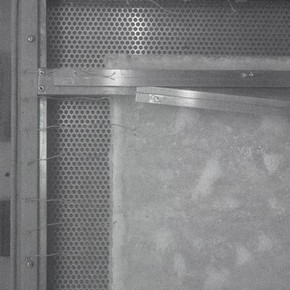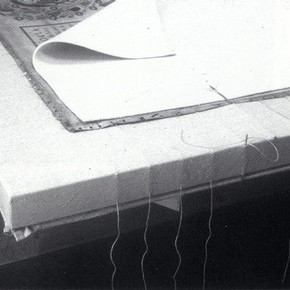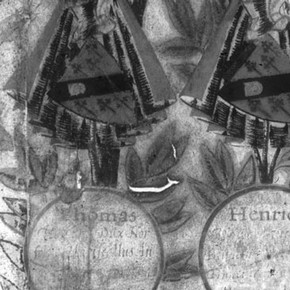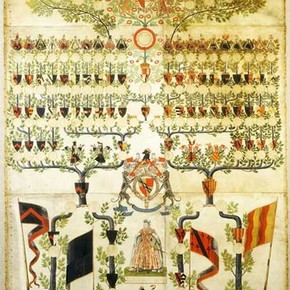Conservation Journal
Autumn 2002 Issue 42
Tethering the cow – Treatment and display of the Sackville Pedigree – a large 16th century heraldic parchment manuscript
This manuscript (MSL.41-1981) was selected for display in the British Galleries – it is a large, showy object which demands to be read. It required a specific display method and a protective environment because of its size and the nature of the material it is made of (parchment). The display also had to be easy to maintain and allow the object to be viewed closely.
The Pedigree is a two-metre high object composed of six sheets of parchment 1 joined together, onto which has been painted a heraldic tree design in water based pigments, including shell gold and silver. It was made in 1599 to celebrate the marriage in 1580 of Robert Sackville to Margaret Howard. Also it was designed to impress and illustrate the Sackville Family’s connection with the Royal Family through the marriage of Anne Boleyn to Henry VIII (Figure 1). Most of the key figures are represented by portrait miniatures. Although there is no firm attribution, the miniature portrait of Robert Sackville is painted in a similar style to those painted by Isaac Oliver – pupil of Hilliard; seventeen years later Oliver painted a large impressive full length miniature portrait of Robert’s son Richard which is also displayed in the British Galleries.
As a manuscript, the Pedigree is an impressive survivor of four hundred years of probable open display, although during that time the once flamboyant silver and white pigments have tarnished to black and some other pigments have faded or flaked away. Paper Conservation in collaboration with University College London, carried out analysis of a selection of pigments using Raman Spectroscopy. The results confirmed the presence of lead white and silver throughout the design. The tarnishing of the pigments is extensive, many of the now black areas would have once been white or silver. For example the whole coat of arms of the Hoo Family – normally described as ‘Quartered silver, white and black’ is totally black – both silver and the lead white have been blackened. Results of analysis of some of the pigments and the colour descriptions used by the College of Arms give a clearer picture of how the Pedigree would have originally looked. There is sufficient information to create a virtual restoration, in the future.
Unlike individual framed portrait miniatures which are more protected, the unglazed portraits on the Pedigree have been damaged through exposure to light, flaking, attrition, tarnishing and overpainting. The portrait in the top right is of Margaret Howard who had died before this Pedigree was made. The pattern of damage to this portrait indicates that another portrait of her had been stuck over the top at one time. As she was not around to paint a good likeness, perhaps the family asked for another of her portraits to be used – it would be interesting, if having fallen off, it is found in some other collection.
Dirt visually disturbed the design especially where trapped in the smears of excess glue along the joins in the parchment. The parchment appears to have been given an overall ingrained dressing of white chalk; this was often done to prepare parchment for painting. It was important not to disturb this, so most of the surface cleaning was done with small pieces of a soft latex sponge. 2 This was used with a small rolling action, which effectively lifted away any loose dirt but did not abrade the surface. In reducing heavier deposits of dirt, the cleaning process involved the minimal use of moisture. This was introduced using pieces of a highly absorbent, fine-textured sponge 3 which when at the right saturation, released just the correct dampness to loosen the dirt, allowing it to be rolled away on a tight, dry cotton wool swab.

Figure 2. Detail of the back of the stretcher showing: 1. The linen threads attached to the steel rods housed in polyester. 2. A corner of the Artsorb quilt sewn to the perforated aluminium. 3. Part of one aluminium split batten used to hang the strtcher in the display case. Photography by Merryl Huxtable. (click image for larger version)
The case for moderate restraint
The cow-skin parchment has fought against attempts to restrain it – much like the tethered cow it once was. The nature of the beast continues in parchment and much like living skin, it is still very reactive to changes in moisture – perhaps more so because in the parchment-making process the skin’s natural oils and fats were removed to make it more receptive to inks and pigments. The Pedigree was drum tight across its support (– a 20th century textile covered wooden stretcher screwed to a plywood board). It was so tight that it had broken the stretcher at two points, had pulled away from edge nails in several places and had torn in some corners.
Clearly previous owners had found it a material reluctant to being secured flat to any structure. There is evidence of at least three –possibly four mountings onto supports. The earliest are lines of stitching holes, then subsequent lines of nail holes. More recent knife cuts around the edge indicate a crude attempt to ease the strain on the parchment to allow the stretcher to lie flat. Copper green had been used extensively to paint the foliage in the design.
Both the parchment and the textile lining show areas which have been degraded by the action of acid in the pigment and they were at risk of splitting when the parchment was under tension. Parchment is known to be an enduring manuscript material, yet it can become seriously distorted if stored unrestrained and exposed to constant changes in relative humidity. It will always want to move around and in some way attempt to revert to its original animal shape and this of course presents specific display problems.
The new support
The proposed treatment of the Pedigree included the removal of the 20th century wooden structure and the mounting onto a new support. This allows it some leeway to move while still keeping it flat but not over tensioned. The Pedigree also needs to be stored in an environment which reduces the rates of moisture absorption and de-sorption and which contains no materials that could further tarnish the pigments. To achieve this, the relatively inert materials, aluminium and polyester, were chosen for the support stretcher and a specification for a shallow microclimate display case was also drawn up.
The stretcher was constructed from ‘u’ sectioned aluminium bars around a panel of perforated aluminium sheeting. One side was covered with a linen-coloured, polyester fabric cover which was specially constructed and fitted in Textile Conservation. To help buffer the parchment against changes in relative humidity, a conditioning ‘quilt’ was made and sewn to the back of the perforated aluminium. This was made by sprinkling Artsorb Beads TM 4 on to one side of a split layer of polyester wadding. This sandwich was then closed by sewing and ultra-sonically welding the wadding quilt fashion, into an outer cover of polyester gauze to trap the beads in pockets. (Figure 2)

Figure 3. Process of attaching the Pedigree to the new support using long needles to pass the linen threads under the textile. Photography Merryl Huxtable. (click image for larger version)
A consultant, Matthew Hatton, specialist conservator of parchment manuscripts at Trinity College Library in Dublin,was invited to advise on and to help with the mounting of the Pedigree onto its new support. The mounting method we chose was developed from a technique designed by the book conservator Christopher Clarkson. It involves holding down the parchment edges with many lengths of twisted linen thread–much as Gulliver was held down by the Lilliputians. When there is an increase in relative humidity the parchment softens and sags a little but the linen threads act in the opposite way; they plump up and the twist tightens, shortening the thread slightly thereby keeping the parchment under gentle tension all round. The opposite happens when the humidity level drops.
The Pedigree was centred face–up on the polyester covered surface of the stretcher. Threads were attached to the verso edges of the parchment at about two centimetre intervals. The other ends of the threads were led under the textile with a long upholstery needle and secured at the back of the stretcher to thin stainless steel rods which lay in long sewn pockets in the textile. These rods were designed to even out the ‘pull’ from the contracting Pedigree and to avoid unsightly puckering of the textile. In the final display the strings are just visible disappearing under the textile around the edge of the Pedigree. Aluminium split battens were used to hang the stretcher inside the display case so that the micro-action of the threads around the edges of the stretcher was not impeded by any fixing mechanisms (Figure 3).

Figure 4. Detail of the coat of arms of Thomas Howard, Duke of Norfolk showing six crosses on a red shield which have tarnished from silver-white to a metalic grey. The acid copper green in the leaves has weakened the parchment causing holes. (click image for larger version)
The low maintenance display environment
The display case was designed as a low maintenance microclimate. In order to periodically monitor the relative humidity in the case without actually opening it, a capped probe port was included mid-way down one side with the facility to hide a connecting data logger behind the case. To alter the relative humidity inside the case, a small hatch has been included just above the probe port, through which a narrow conditioning panel can be accessed from behind the stretcher. This panel is of Perspex TM covered in a mini version of the Artsorb quilt. It can be removed and conditioned appropriately before being reinserted into the case to introduce or take-up humidity in the case. The shallow case design also allows close inspection of the written surface of the Pedigree.
Acknowledgements
My thanks to colleagues in the V&A especially Bill Johnson, Technical Services, Graham Martin Head of Conservation Science, Albertina Cogram,Textile Conservation and Paul Robbins, V&A Photo Studio. Also to Matthew Hatton, Conservation Department at Trinity College Library, and colleagues in the British Library and Public Record Office for their advice on the display of parchment.
References
Autumn 2002 Issue 42
- Editorial
- Travelling altar: Investigating an object
- From first aid to fluorite: Identification of a rare purple pigment
- Queen Elizabeth’s virginal scribbles, scratches and sgraffito
- Continued studies in the deterioration of glass
- Tethering the cow – Treatment and display of the Sackville Pedigree – a large 16th century heraldic parchment manuscript
- News from RCA/V&A Conservation
- Printer friendly version
